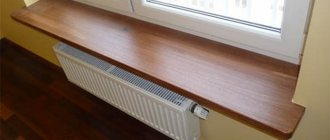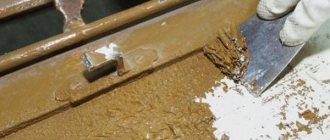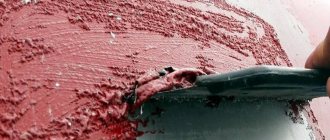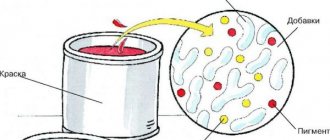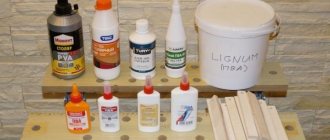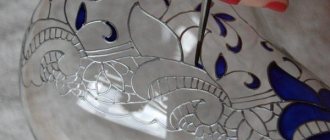how to remove oil-based paint from wood to prepare a door for a new coating Treated wood surfaces are often coated with oil-based paint to protect the surface from the elements, as well as to change the design of the product.
Over time, layers of oil paint begin to crack and peel off. It's time to decide how to remove oil paint from wood to prepare the base for a new coating.
Getting started, preparing tools
To remove paint from wood, you need to determine the scope of work. You should find out how many layers were applied previously. The type of paint also plays a role, since the degree of adhesion, and therefore the ease of performing the work, depends on this.
Factors to take into account:
- one layer of finishing does not have to be removed, it is sanded, then a new one is applied;
- you should find out what type of wood the structure is made of, as it may be difficult to clean and further process;
- if the product needs to be painted in a lighter shade, the top layer must be completely removed;
- determine the type of structure (stationary, portable), since it is not always possible to use aggressive chemicals indoors; some things are taken out into the fresh air for treatment.
When choosing a way to remove old paint from a wooden surface, they also pay attention to the technology for its implementation, while choosing tools and materials:
- electric drill;
- wash;
- spatulas of different widths;
- sandpaper;
- hair dryer;
- lint-free rags;
- brushes with metal bristles;
- Angle grinder.
You need to wear protective equipment when working. You will need a respirator or mask (the choice is made when deciding how to remove old paint: chemically or mechanically), gloves, and goggles.
Important: If the treatment will be carried out outside, you need to check the weather for the coming days. Other important factors that you should find out about in advance: the age of the foundation, the operating conditions of the structure.
Advantages and disadvantages of home and industrial methods
After analyzing all the methods, we have collected the pros and cons of each of them in a table.
| Name | pros | Minuses |
| Mechanical manual processing | harmless to health; the ability to remove paint in hard-to-reach places; no dust is generated; no smell; It is possible to carry out cleaning indoors at any air temperature. | requires time; a special tool is required; you need to put in physical effort; the wood surface gets damaged (cuts, chips, scratches). |
| Mechanical automated cleaning | the fastest way to remove paintwork; effective for all types of paint; when using the correct attachment, it practically does not damage the wooden base; it is possible to quickly process large areas; can be used at any air temperature. | it is impossible to clean paint in hard-to-reach places; expensive consumables; a lot of dust is generated; work must be carried out outdoors; When using metal brushes, visible circular damage to the wood material is formed. |
| Thermal removal | almost completely removes old coating; suitable for cleaning hard-to-reach places; used for any type of paint. | take a lot of time; toxic fumes are released when heated; it is necessary to work away from plastic and glass surfaces; There is a danger of wood fire and hand burns. With constant operation, the hot air gun overheats. |
| Chemical remover | high processing speed of painted surfaces; ease of application on vertical surfaces due to the gel structure; does not damage the wood structure; convenient to remove paintwork in hard-to-reach places; | high material consumption; toxic fumes are released; the products are dangerous if they come into contact with the skin and mucous membranes; the ability to work only at temperatures of +5 degrees and above in the open air; Not suitable for all types of coating. |
One way or another, each method involves mechanical action on a wooden surface. Thermal and chemical exposure is always followed by removal of the old layer using metal scrapers. The final treatment is sanding and sanding the wood base.
When choosing a suitable way of working, assess the scale of the upcoming activity. Perhaps it is enough to clean it with simple sandpaper, or you may have to spend a week and enough money to update the wooden facade.
Paint Removal Options
All technologies are divided into 4 groups. If you need to choose a way to remove old paint from wood, you should consider:
- Mechanical damage: use simple tools, but only old finishes or multi-layer coatings can be scraped off with this method;
- a method based on the use of a heat source: removal of paint and varnish material is carried out by exposure to elevated temperatures (a powerful household or construction hair dryer, gas burner);
- chemical: the old layer can be washed off with special compounds;
- sandblasting: removal of paint from wood (doors, skirting boards, wall panels and other products) is carried out using equipment, with an intense abrasive effect.
Mechanical method
The surface cleaning technique is based on the use of sandpaper, a stiff brush (made of metal) or a power tool - drill, angle grinder. In this case, the surface layer is removed.
This option is suitable for cases when choosing a technology for removing paint from a wooden surface, provided that the coating is thin.
Processing the product with sandpaper or a scraper (grater)
Consider abrasives of different grain sizes. The processing technique is the same: with monotonous movements (circular or reciprocating) the old layer of finishing is cleaned.
You need to start with coarse sandpaper. Then sand with fine-grained paper.
Cleaning the surface with an angle grinder (angle grinder)
You need to learn how to remove old paint from wood safely for the entire structure. Features of the method:
- a sander is used when a coating of significant thickness is applied;
- Angle grinders are used to remove lower layers of finishing;
- when performing the processing procedure, the average operating speed of the device is set;
- prepare a disk with an abrasive surface (petal).
Using a drill
The high speed of implementation of the method is noted. The tool must be positioned perpendicular to the surface being processed. You can use attachments that increase grinding efficiency.
A drill is convenient to use if you need to remove old paint from areas of complex configuration or wooden surfaces of small parts.
Removing the coating with a wire brush
When using a cord brush (with metal bristles), the likelihood of damaging the base increases. For this reason, when you need to choose a method for removing paint from wood, consider this option last, and only as a backup. After this, you often have to sand the wood.
Thermal method
Involves exposure to high temperatures. Options:
- hair dryer: does not always provide the desired effect (weak effect);
- gas burner (note a high risk of a fire hazard);
- iron and foil, after applying the method, use the mechanical impact technique.
Chemical method
Before you begin removing the finishing layer, you need to ensure air flow into the room (if it is not possible to take the structure outside). Also protect surrounding objects with polyethylene.
Features of choosing and using wood paint remover:
- consider gel-like substances and liquids, the first option works faster and better;
- if wooden surfaces are quickly damaged, choose non-aggressive substances;
- The remover may not be suitable for removing multi-layer coatings.
Sandblasting: grinding with fine abrasive
If you do not have experience and skills in working with equipment, choose another method to clean old paint.
The difficulty of using sandblasting technology lies in the high risk of damage to wood.
The method is based on the delivery of solid particles to the coating using a jet of water. Its main advantage is a completely ready surface for further work with fresh composition.
Key features of paint and varnish removers from wood
Chemical removers for paint and varnish on wood are a category of specialized solutions that quickly dissolve or loosen old layers of paintwork. As a result, the adhesive properties of the latter deteriorate. When compared with mechanical methods of cleaning surfaces, a more even, smooth wood is formed here, which is free of abrasive damage and signs of abrasions. Chemical treatment does not affect the original properties of the base.
The wash can be used locally if you choose a sufficiently viscous composition: the gel consistency will not allow the reagents to spread over the surface. Therefore, the substances are convenient to use not only when restoring large wooden structures, but also when restoring interior items and furniture.
Remover-gel for removing old paint and varnish coatings
When choosing the best option, several factors must be taken into account:
- compliance with the type of layer to be removed and the specifics of the working composition - this way you can avoid an undesirable destructive effect;
- if there is a large area to be processed, it is more advisable to use a solution that operates relatively quickly so that there is no downtime;
- the instructions always indicate at what humidity and ambient temperature this product can be used; real conditions must correspond to the given parameters;
- the composition should not contain toxic components.
The simpler the proposed application technology, the better: it is important that convenient tools are available so that the density of the substance corresponds to the tasks.
Characteristics of a successful remover for oil or any other paint:
- versatility of use;
- gentle wood processing;
- fast action;
- fire safety;
- absence of unpleasant odors;
- economical consumption;
- deep penetration;
- maintaining original properties after defrosting.
High-quality preparations are effective for removing old paint even at sub-zero temperatures; they must be safe for humans.
Which option should you choose?
When deciding how to remove old paint from wood, the following factors are taken into account:
- to reduce costs, a mechanical method is chosen, but this process is lengthy, and it will not be possible to completely clean the multilayer coating without damaging the base;
- speeds up the procedure for removing the coating using a chemical method, but takes into account the possibility of ventilating the room or transporting the processed product outside;
- Sandblasting at home is not used without equipment and experience;
- the thermal method is one of the available ones; if there is no hair dryer, a household hair dryer is used (provided that it is characterized by high power, since this promotes rapid heating of the surface), a gas burner and even an iron with foil can be used, but in both cases there is a risk the formation of dark spots on wood increases many times over.
Methods for removing old coating from wood
The durability and quality of repairs directly depends on the preparation of the base. Of course, you can apply a new coating over the old one, but the appearance of such a finish will be far from ideal, and the durability of the coating remains a big question. Therefore, so that the time spent on repairs and money on materials are not wasted, it is necessary to remove the old paintwork.
There are several ways to perform this procedure:
- Mechanical;
- Thermal;
- Chemical.
To make it clearer what the advantages of washing are, let’s briefly consider the features of these methods.
Removing paint with sandpaper
Mechanical
The oldest and most famous is the mechanical method. As a rule, there is no alternative to it in small areas. It is done with your own hands using a sharp tool or sandpaper. With a lot of effort, after some time you can get an acceptable result. .
If you need to clear a large area of old finishing, you will have to use a power tool, for example, a grinder or a drill with a special attachment. This work takes a lot of time and effort, and it is not always possible to achieve the desired result.
Another serious disadvantage of this type of paint removal is the high likelihood of damage to the wood surface.
Removing paint using a hair dryer
Thermal
A much more technologically advanced method is the thermal method. Previously, irons were used for these purposes, which heated paint through foil, and blowtorches. In our time, construction hair dryers have appeared, which have greatly simplified this procedure. .
The essence of this method is that the paint is heated to a high temperature, after which it softens and swells. After this, it can be easily removed with a scraper or brush.
This method is more effective and not as dusty as the mechanical one, however, it is not always possible to use it. In addition, you will need a professional-grade hair dryer, which not everyone has.
In the photo - applying the wash
Chemical
Not so long ago, this method was ineffective and quite dangerous. As a rule, it consisted of using solvents corresponding to the type of painted surface. In addition, there are folk recipes that contain dangerous acids or alkalis .
However, all these products, in addition to being toxic, are ineffective in removing multi-layer coatings. In addition, solvents quickly begin to evaporate, reducing the effectiveness of this method to zero and saturating everything around with toxic fumes.
The situation has changed dramatically with the advent of special removers, which loosen old paint and make it extremely easy to remove mechanically. The main advantage of the remover is the ability to remove paint without damaging the surface of the wood.
Subtleties of removing different types of dyes
Will be considered:
- Acrylic compositions. They are removed chemically. It is also recommended to use the method of exposure to a heat source, after which it is proposed to remove the softened layer.
- Oil compositions. They can be wiped off with a chemical remover. The method of mechanical action is also effective (multilayer old coating is removed with a spatula).
- Water-based compositions. Solvents are ineffective in this case. The mechanical option is considered first.
Chemical cleaning
The next effective cleaning method worth mentioning here is chemical. The advantages of this method are the absence of dust and speed. The surface is coated with special compounds, which, being absorbed into the layers of paint, liquefy it and foam.
After this procedure, it is not difficult to remove the paint using conventional methods. To prevent liquid from draining from the substrate, manufacturers often produce it in the form of jelly.
Pictured: Chemical paint cleaning is an easy way to get rid of old paint.
With this composition it is easy to remove old paint from any surface - even the ceiling! However, when using this method, there are a number of disadvantages. The composition itself and the vapors released by it are very toxic. Also, the price of good solvents for old paint may exceed the cost of the paint itself. It is best to combine this method with the previous one.
For example, clean a large, flat surface with a grinder, and treat hard-to-reach places with a chemical compound.
Homemade wash
It is not difficult to clean objects from paint and varnish material using improvised means. Prepare homemade liquids for removing paint from wood. Recipe:
- You will need: caustic soda (1 kg), the same amount of chalk, slaked lime (0.9 kg), liquid (4.5 l). The ratio of components is maintained, but the proportions can be changed.
- Dilute the soda with water, heat the solution to +60°C.
- Add chalk and lime to the mixture and mix until a uniform consistency is formed.
What you need to know about the properties of oil paint
Oil paint is a paint and varnish material that consists of vegetable oils or drying oils, fillers and pigments, on which the properties of the paint depend:
- dries depending on the type of oil and pigment;
- creates a layer of medium strength;
- does not change color after drying;
- is water resistant;
- is destroyed under the influence of an alkaline environment;
- As the drying temperature increases, the resistance of the oil film increases.
Oil paint is often used to coat wooden surfaces because it has high adhesion to wood.
Basic rules and recommendations
To avoid mistakes, you need to learn more about the features of cleaning wood from paint and varnish material:
- before use, the chemical must be applied pointwise to the surface in an inconspicuous place to check how the remover affects the wood;
- the chemical is applied to the entire area at once;
- finishing liquids should not last longer than 2 hours, as this will damage the base;
- It is not recommended to pour the remover into plastic containers (it can ruin it);
- when working with heat sources, do not overheat the base;
- when the mechanical method is chosen, the forces applied should be controlled, since the wood is easily damaged.
Thus, each method of removing paints and varnishes has advantages and disadvantages. They are used under various conditions. You cannot use an inappropriate method, because... at the same time, the risk of developing irreversible processes increases (furrows, cinders, differences in surface levels at different points of the structure remain).
Necessary equipment
The following devices are useful for mechanical cleaning:
- chisel, metal scrapers;
- abrasive paper of different grain sizes;
- metal brush;
- grinding machine with attachments.
Heat treatment will require devices that emit heat. A hair dryer is mainly used. This device allows you to regulate the temperature and increase it up to 600 degrees Celsius. A household analogue will not work, since it quickly overheats and is not able to produce a suitable temperature.
Chemical method
requires the presence of special solvents:
- industrial special tools for paint removal;
- household paint solvents.
As they say in the safety instructions: “Nothing pleases the eye like a second eye.” So don't forget about yourself. Working with electrical appliances, sharp, piercing objects, and chemicals can be harmful to health, even if you have a “virtuoso builder” certificate.
Don't forget about safety precautions:
- When working with sharp objects, protect your hands with gloves. Wear safety glasses. Hold the tool away from you. Do not put your fingers under the edge of the cutting object.
- If you use mechanisms with rotating parts, be sure to make sure that the laces and loose ends of clothing are hidden. Use goggles or special masks to protect your eyes.
- When working with a construction hair dryer, protect your eyes and respiratory organs from fumes of melted paint. Goggles and a respirator are required. Do not expose your hands to hot air to avoid burns.
- Chemical treatment must be carried out in full equipment: goggles, protective mask (respirator), rubber gloves.
Mechanical removal of paintwork materials
Please note that not all paint can be mechanically cleaned. For example, modern acrylic enamel easily beats any sandpaper. The effect depends on the area of the surface being processed, on the power of the tool and the abrasive used. If you need to “tear off” a small island of paint, you can clean it with sandpaper. In other cases, a more serious approach will be required.
Cleaning with a chisel and special scrapers
This method is suitable for hard wood. Cleaning paint in this way is similar to the sanding process, when a thin layer of wood is removed using a carpenter's tool. Here we remove a thin layer of wood along with the paintwork. This method is used on flat and shaped surfaces. To perform it you need to have sufficient physical strength.
How to perform the operation:
- The tool must be sharpened. This is the main key to success.
- The chisel should be held in the palm of your hand so that the tip protrudes from the underside of the fist by about 3 cm.
- Press the tool perpendicular to the wood.
- While pressing, make scraping movements in one direction. It is more convenient to make such movements towards yourself.
To clean the protrusions and grooves, use special sharpened curly scrapers.
Axe
This technique is good for surfaces with cracked or peeling paint. If you only have an ax at hand, sharpen it and get started. The technique differs from working with a chisel:
- The tip of the ax should be positioned to the surface at an angle of approximately 30 degrees.
- You need to hold the butt with one hand, and press on the canvas with the fingers of the other.
- Make gentle scraping movements away from you.
It may not be possible to remove all the paint this way, but it is possible to remove most of the coating.
Wire brush
This is the most aggressive method because the hard metal bristles scrape away the soft part of the wood. The result is an uneven surface.
But if you are satisfied with the future result, then just take a brush and clean the surface until all the paint comes off. We warn you that the work will require physical effort and time.
Cleaning with a grinder
The fastest, most effective and dustiest way. Although the latter is debatable. New tools are equipped with dust collectors. Thanks to this, work turns into pleasure.
Well, if you work the old fashioned way, get ready for dust to settle in the most unpredictable places. A great option is to work outdoors. This will allow you to avoid inhaling dust and save yourself from cleaning.
There are different attachments sold for angle grinders. The most effective are sanding wheels for removing paint. They are also called coral circles. Special abrasive material and large pores are designed to prevent the disc from clogging. Such attachments work much more effectively on thick paint coatings than conventional abrasive counterparts.
The price for such circles varies from 200 to 1100 rubles. The most popular manufacturers:
- M3;
- GTOOL GROUP;
- Russian master.
Instances from Aliexpress look like coral discs and even work, but not for long.
The abrasive material has varying degrees of hardness, which allows you to delicately process a wooden surface without significant damage. We recommend working with such nozzles at high speeds (4000 rpm).
At first glance, a budget option for an attachment is a simple abrasive wheel with Velcro with the coarsest grain size. To prevent the surface from clogging very intensively, the Grinder is set at low speeds. The rotations should be enough to maintain power to process the material, while the engine should not stall.
If you compare the efficiency and degree of wear of a conventional abrasive wheel and a coral attachment, you can come to the conclusion that a coral disc is more profitable to purchase. One abrasive attachment loses its properties after processing 1 m2, and wear of the coral analogue occurs after approximately 10 m2.
Thermal
Tormented by the issues of updating the faded beauty of wooden things, we are forcing manufacturers of consumer goods to move. And they often delight us with their decisions. For example, a construction hot air gun. This is a universal worker who solves dozens of problems where elevated temperatures are needed.
Synthetic paints tend to soften when exposed to heat. This feature is used to remove paintwork from wood. But it is important not to forget about the flammable properties of wood and not to set the heating temperature above 200 degrees.
Hot air gun with nozzle
Known methods are quite effective when performed correctly. Manufacturers of construction hair dryers now offer a special attachment for cleaning paint. It looks like a spatula that is put on the nozzle of a hair dryer.
How to do the job:
- Place the nozzle on the hair dryer.
- Set the heating level to 180-200 degrees Celsius.
- Turn on the device, press the spatula against the surface to be cleaned and slowly begin to scrape off the soft paint in one direction (away from you).
When working with a hairdryer, you do not need to make chaotic movements. Let the paint layer warm up evenly and remove it at the same time. Having gained a little experience, you will get used to performing this simple operation.
Construction hair dryer and spatula
If you own an old modification of a hot air gun, without special attachments, you will need additional equipment in the form of a spatula.
Method for cleaning wood from paint and varnish:
- Take a hairdryer in one hand and a spatula in the other.
- Press the spatula onto the surface to be cleaned at an angle of approximately 45 degrees.
- Bring the hair dryer to the spatula blade so that the nozzle points in the same direction as the edge of the spatula, and the air flow partially hits the metal and painted wood surface. Do not direct the air flow perpendicular to the canvas, as you may burn your fingers.
- After heating the paint, slowly begin to collect it with a spatula, moving in one direction. Sometimes it is more effective to make scraping movements. Paint coatings react differently to heat: some melt, while others come off in layers.
- Make movements away from you or to the side. To avoid burns, do not expose your fingers to the hot air stream.
Iron and towel
Another unconventional method that has been tested in practice is heating a coating of oil paint with an iron with a steam generator. This method is suitable for horizontal surfaces.
To work we need an iron, a towel and a spatula. We recommend working in the following sequence:
- Cover the area to be cleaned with a terry towel.
- Turn the iron into steam generator mode or use a special button that produces hot steam.
- Iron the surface of the towel for 30 seconds.
- Place the iron on the edge of the towel for a few seconds and heat the area of paint. Move the iron to the next area of paint, at the same time peel back the fabric and clean off the softened coating.
- So, warm the surface in small segments and remove all the paint.
Cleaning clothes from stains
When paint gets on clothes, it must be soaked in cold water. The low temperature prevents the acrylic from penetrating into the fibers of the fabric, so removing the stain will be much easier.
If the contamination is fresh, then after soaking you need to use one of the following products:
- Dishwashing liquid. Rub the stain thoroughly with detergent and leave for 3 hours. Then rinse the clothes thoroughly and wash them by hand or in the washing machine.
- Isopropanol (sold at pharmacies). It is necessary to remove excess liquid from the fabric, then soak the napkin in isopropyl alcohol and apply it to the stain. After a quarter of an hour, clean the fabric with a coin or fingernail. Wash clothes as usual.
- A mixture of ammonia, salt and vinegar. Mix the ingredients in equal proportions. Apply the mixture to the stain with a sponge and wait a little. Rinse the area with water and evaluate the result.
- WD-40. Can be purchased at a hardware store. You need to remove some of the paint, then spray the product on the stain. After twenty minutes, rub the fabric with a sponge. Scrape off the remaining acrylic with a knife and wash the clothes. The method is suitable for dense fabrics.
- Hair fixation spray. Used when processing fabrics that require careful handling. You need to spray the stain with varnish and blot it with a sponge, then wash the product.
Dried acrylic paint is difficult to wash off. You cannot do without the use of chemicals:
- Refined gasoline. Apply the product to the stain. After a few minutes, wash the item and rinse in water with vinegar to remove the smell.
- Ammonia and vinegar. Prepare a solution of 200 ml of ammonia, 200 ml of vinegar and 1 tsp. salt. Dip a sponge in the mixture and rub the stain on damp clothing. After the contamination disappears, the item needs to be rinsed.
- Denatured alcohol. Pour the liquid onto the stain and wait five minutes. Rinse and machine wash clothes.
Oxygen bleach, such as Vanish, can handle stains on white fabrics. It must be used according to the instructions. White spirit can be used to clean dense matter.
Remover is a special solvent designed to remove acrylic marks. It is applied with a brush to the stain. After ten minutes, the acrylic along with the remover is removed with a sponge, and the clothes are washed. To improve the result, baking soda is added to the solvent.
